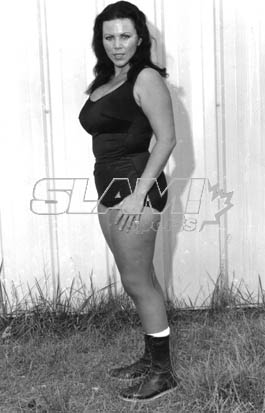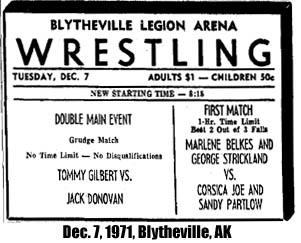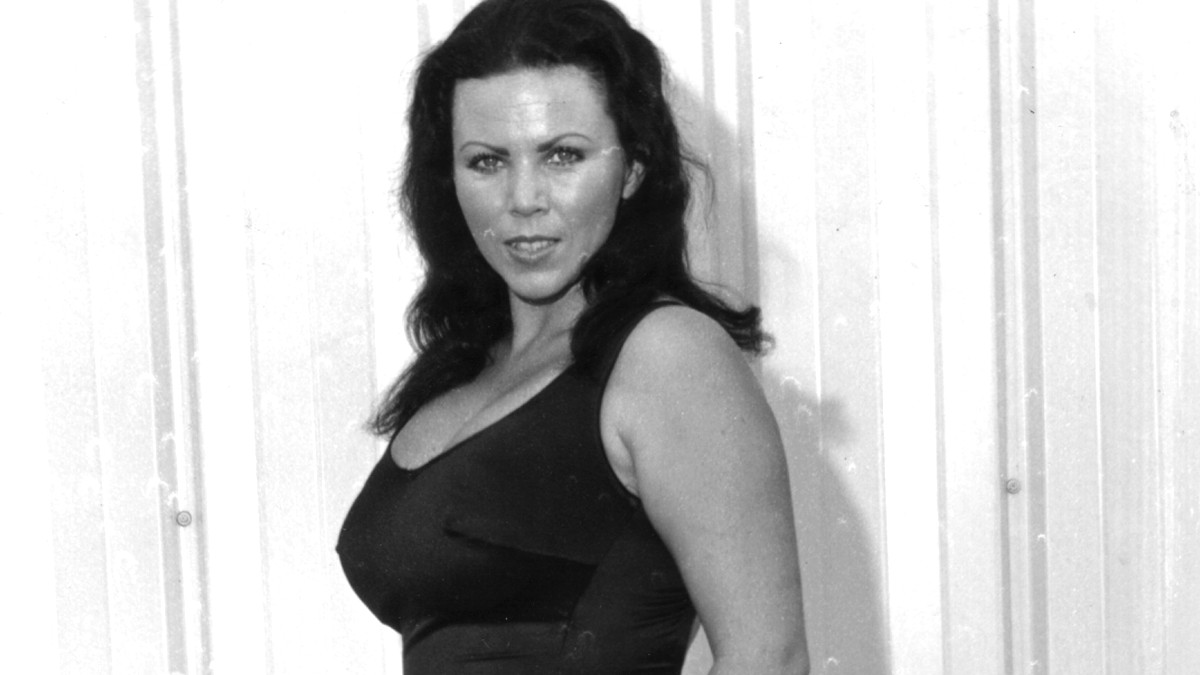For anyone who saw Sandy Partlow wrestle, it was pretty obvious that she was good at what she did, and that she enjoyed it. What most people don’t know is that wrestling had come easy to her from day one.
Partlow only trained for six weeks at the Kansas City Athletic Club, upstairs at the Continental Hotel, with promoter Bob Geigel and woman wrestler Betty Nicoli.

Sandy Partlow. Courtesy of the Wrestling Revue Archives
“It’s the easiest thing I ever did in my life,” Partlow told SLAM! Wrestling. “I guess I just wanted it so bad and Bob Geigel said I was just a natural at it. And I never got in the ring until the morning of the day I was supposed to wrestle. That was my first time in the ring.”
Smartened up to the inner workings of the business just before her first match on June 5, 1969 for promoter Joe Dusek in Lenox, Iowa, Partlow went over against Nicoli.
“Joe Dusek called Bob Geigel the next day and said, ‘Where have you been hiding her, and where have you been keeping her? She’s been working for at least five years. Don’t lie to me, Geigel, I know it!'” laughed Partlow at the memories.
Partlow is one to laugh easily, and swears that she has never been unhappy in her life and bears no grudges. She even speaks highly of Nashville promoter Nick Gulas, a real rarity in this writer’s experience.
Born January 18, 1951 in Kansas City, Kansas, to a father who was a roofer and a homemaker mother, Partlow — a legit 100% Native American — grew up in Kansas City until she was seven years old, then moved to a suburb, Edwardsville, about 20 minutes from downtown KC. She went to Bonner Springs High School, but didn’t graduate, quitting in the 11th grade, learning to wrestle, in part to help her parents out financially.
Wrestling didn’t enter her life until she was 17. Before that, it was horses. In fact, it still is.
“Oh God, my mom put me on a horse when I was six months old, and rode me around. I just grew up riding horses. That was my main hobby, I guess,” she said. “It was always horses, riding and showing horses.”

One day, her father saw that Lou Thesz would be wrestling in Kansas City, and he wanted to see the legend, who he had watched as a kid. He dragged his daughter along, who was awed by Thesz as well. “He was a wonderful, wonderful, wonderful wrestler; could do more with one hand than most men could do with both arms and legs,” Partlow raved.
A week later, Thesz was back and so were the Partlows. This time, it was the women wrestlers that entranced Partlow.
“I thought, ‘Oh, okay, heck, I can do that,'” recalled Partlow. She got up the nerve to talk to one of the wrestlers, Nicoli, who told her to come back and train when she was 18 years old. As soon as that happened, Partlow was back, convincing Nicoli and Geigel to train her.
While Partlow praises Geigel as a “gentleman,” she is less than complimentary about Nicoli. “She taught me the basics, because she just wanted me to learn the basics, just enough so I could have a match with her and she could look fabulous.”
Booked out of Geigel’s Missouri office, the 5-foot-1, 122-pound Partlow traveled, traveled and traveled.
“My God, I’ve been to every province in Canada except British Columbia, Japan, Mexico. Everywhere I learned,” she said. “I was happy with what I did, and I went where I wanted to go, worked with who I wanted to work with. I don’t know, I kind of broke in with a silver spoon in my mouth.”
Sandy Partlow screams while trapped in Cora Combs’ hold. Courtesy Chris Swisher
Her mentors became Jean Antone, who taught her how to be a heel, and Cora Combs.
Combs was a regular opponent in Tennessee for seven years. “She taught me more, she wrestled the way I wanted to wrestle, scientific. I got my heat — of course, I was heel — and I got my heat through holds and she was more scientific, more knowledgeable than any person that I have ever worked with in the business. I love that woman. I have a dear place in my heart for her, and I always will.”
Princess Partlow
The irony is that, as good as Partlow might have been as a heel, she is also fondly remembered as Princess Partlow. But she said she was never comfortable with the Native American “gimmick,” mainly because she wanted to be a heel, “Heeling was in my heart from the very beginning.”
“Sandy was as good a girl wrestler as there ever was. She was a petite, not real big, but my God, that Indian persona, just going out, the people liked her right away,” recalled Sir Oliver Humperdink. “All my time around her, she was always Princess Sandy Partlow, so she was a babyface. She had that ‘it’ quality too, where people just liked her.”
The other name that Partlow used was Judy Dare, a heel, which started in Montreal for the Vachons and Grand Prix Wrestling. Working in Texas against Antone, she dared to be Dare. “But they knew me in Texas and all around as Partlow. They announced me in the ring as Judy Dare, and this lady hollers, ‘You’re not Judy Dare, you’re Sandy Partlow!’ I just cracked up in the ring. The referee says, ‘Get that smile off your face.’ I said, ‘I can’t help it. My cover’s blown.'”
Even as a heel, though, Partlow had a tough time being mean outside the ring. “The first thing you learn is you protect the business, because that’s your livelihood,” she explained. “When I walked in the door, I was a wrestler; when I left the door to go outside I was Sandy Partlow.”
Like all wrestlers, sometimes she left injured.
In northern Minnesota, the fans were too close to the ring, and in the battle royale, Partlow went over the top rope, about to land on a little old lady. “So I grabbed the top rope when I went over and hyperextended my arm and broke my collarbone.” She wrestled for two months with it broken before sitting off six weeks to heal.
Sandy Partlow and Early Dawn. Courtesy of the Wrestling Revue Archives
Another time, Sylvia Hackney hit her in the ring, and Partlow’s teeth went through her lower lip. “We were about three minutes into the match. There was blood all over me, on the referee, all over the mat and all over her. He said, ‘I’m stopping the match.’ I said, ‘No, you’re not! We’re finishing this match.'”
Partlow described her style as “just basic wrestling. I mean, I did a lot of vicious bumps and stuff like that, stuff off the top rope. It was more solid wrestling is what it was, solid heel wrestling, is what I would call it.” Her finishers are downright quaint in this age of highspot after highspot — a suplex, or a running bodyslam. “Back then, a girl doing a suplex, it was a finishing hold.”
While she worked around the globe, Tennessee was best to her. “My favorite promoter of all was Nick Gulas,” she said. “I made money for that man, I honest to God did, and we made money with him.” Outside of Nashville and Memphis, there weren’t a lot of big towns, so that may have coloured the negative thinking on Gulas. “The boys shouldn’t complain, they were working every night. Maybe some of them didn’t make what they thought they could make up north in New York, or the other territories,” she defended. It was out of Nashville that she worked a long program with Combs that got TV time and headlining status on some live shows — both extreme rarities for women’s wrestling.
“She has a pretty incredible track history. She was a fantastic heel. That’s what she did and she did it best. When she was working against Cora Combs all those years in Nashville, they would have cage matches and hair matches, chain matches. They would work main event often times over the guy,” recalled Partlow’s daughter, Tonya. “When I was a little girl, my grandparents and I would have to be escorted in by several security guards because she had so much heat. That’s pretty amazing for a woman. The guys could do it, but she was a superb heel. As I was a kid, and I’d be sitting in the audience, I would have to sit there and keep a straight face while she was in the ring. It wasn’t always easy.”
In the same territory, Partlow got to know Elvis Presley, who was a big wrestling fan. “He was a very sweet guy, very nice, totally a country boy,” she said, launching into a story. “I was working with Cora one night in Memphis, and the referee says, ‘Guess who’s here?’ So I turned and looked over at the dressing room, and you could see him coming in. He looked at us and waved at us, and I waved back at him. It’s like the whole crowd just went bee-doop, and turned; it’s like they automatically knew that he was there.” Frequent visits to the Grand Ol’ Opry resulted in her meeting the likes of Emmylou Harris, Ray Stevens and Hank Snow as well.
Financially, Partlow said she had some $1,200 weeks, but generally was it was less, up and down. “It just depended on the house and what was going on,” she said, adding that wrestlers have to spend a lot of money on the road just to live, which people don’t realize. And the women, traveling more than the men who could homestead, faced greater challenges.
The biggest show she ever worked was the Sam Muchnick retirement show in 1983, where Wendi Richter and Joyce Grable beat Sandy Partlow and Early Dawn, when Dawn was pinned. “She didn’t want to do the job. It’s like, ‘Who cares?’ you know.”
Partlow worked 23 years, into 1992, balking when offered $10 for a night’s work on a small show. She had been able to team with her daughter, Tonya Partlow, for a number of matches.
“My daughter was grown and I just didn’t want to go out anymore,” Partlow said. “There wasn’t anybody left to wrestle, and some of the girls you did wrestle, it was like, ‘Oh my God!'” For example, there was the nail technician by day who had started wrestling and didn’t want to break any nails … so Sandy popped one of her nails “just to be ornery.”
Married just once, for two years, to wrestler Buzz Tyler, Partlow’s daughter comes from a union with wrestler “Killer” Tim Brooks — who Tonya only recently met for the first time with the knowledge of who he actually was.
“It was a surprise, but the best thing that ever happened to me,” Partlow said of her daughter’s birth in 1980. Since she still lived at home, at least according to the taxman, Partlow had insurance through her dad, and that’s how the hospital bill was paid. It’s also how Tonya was raised — by her grandparents — with mom on the road so much. Partlow only realized she was pregnant three months into her term, and stayed off for only a couple of months.
Mom and daughter would travel to countless shows, until the teenager thought hanging around mom was uncool.
“I think she grew up smart,” Partlow said of her daughter. “She was always in the dressing room with me and the girls I worked with. With friends, like Jean Antone, I’d be over at her house, and Tonya was always with me … I never really had to smarten her up to the business because she was born into it.”
Looking back, Tonya DuRoche, married with a daughter, can be in awe of her experiences as a wrestling brat. “I was mad at her for several years for traveling so much, but then, after I thought about, I realized she did what she wanted to do,” Tonya said. “She was passionate about it. She has wonderful stories to tell. I traveled to 39 states and met who knows how many people, and it is what it is.”
Mother and daughter still work together these days.
Sandy makes horse tack — bridles, halters, and other horse essentials — and supplies a number of stores. She has plans to open a store with her daughter around Minneapolis to sell Western handbags.
There are no regrets, other than being away from her daughter so much.
“I loved the business and the business was good to me. I tried to be good to the business. I always protected it.”
Greg Oliver chased Sandy for more than half a year, then got her on the phone, and she wouldn’t stop talking. Wonderful, wonderful stories.
